Leading Change: Organizational Impact, Drivers and Behavior Report
VerifiedAdded on 2023/01/12
|12
|3714
|92
Report
AI Summary
This report examines leading change within organizations, focusing on the impact of change on strategy, operations, and organizational behavior. It begins with an introduction to leading change, defining its role in preparing employees for change implementation. The report uses Facebook and Google as case studies to illustrate organizational change, including structural, strategic, process, and people changes. It analyzes internal and external drivers of change, such as technological advancements and human resource innovation, and their influence on leadership, team dynamics, and individual behaviors. The report evaluates the application of systems theory and continuous improvement models in responding to change. It also explores the Bohner and Arnold Analysis model for understanding change impact. The conclusion provides recommendations for effectively planning for change and applying change impact analysis, drawing on the case studies and theoretical frameworks discussed throughout the report.
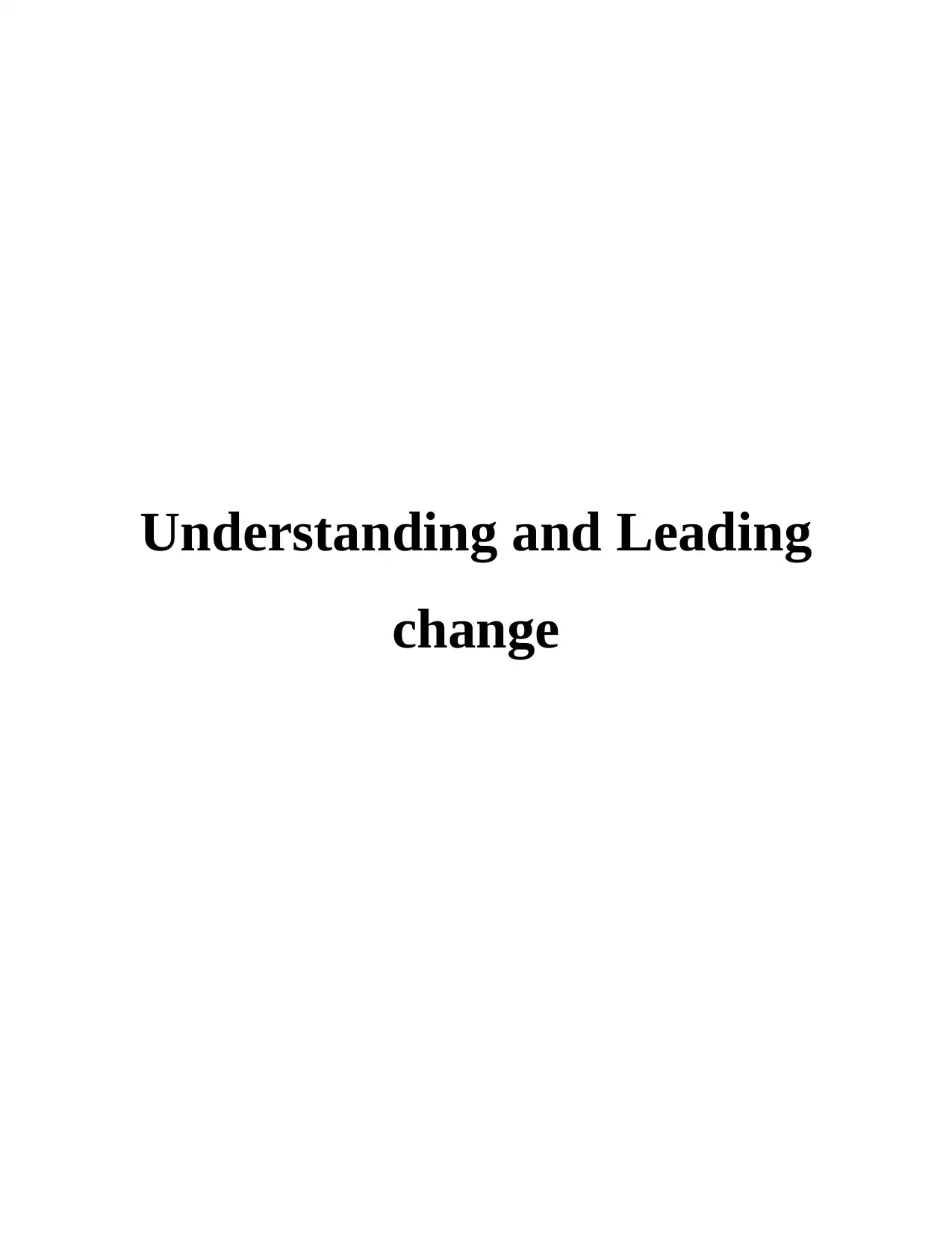
Understanding and Leading
change
change
Paraphrase This Document
Need a fresh take? Get an instant paraphrase of this document with our AI Paraphraser
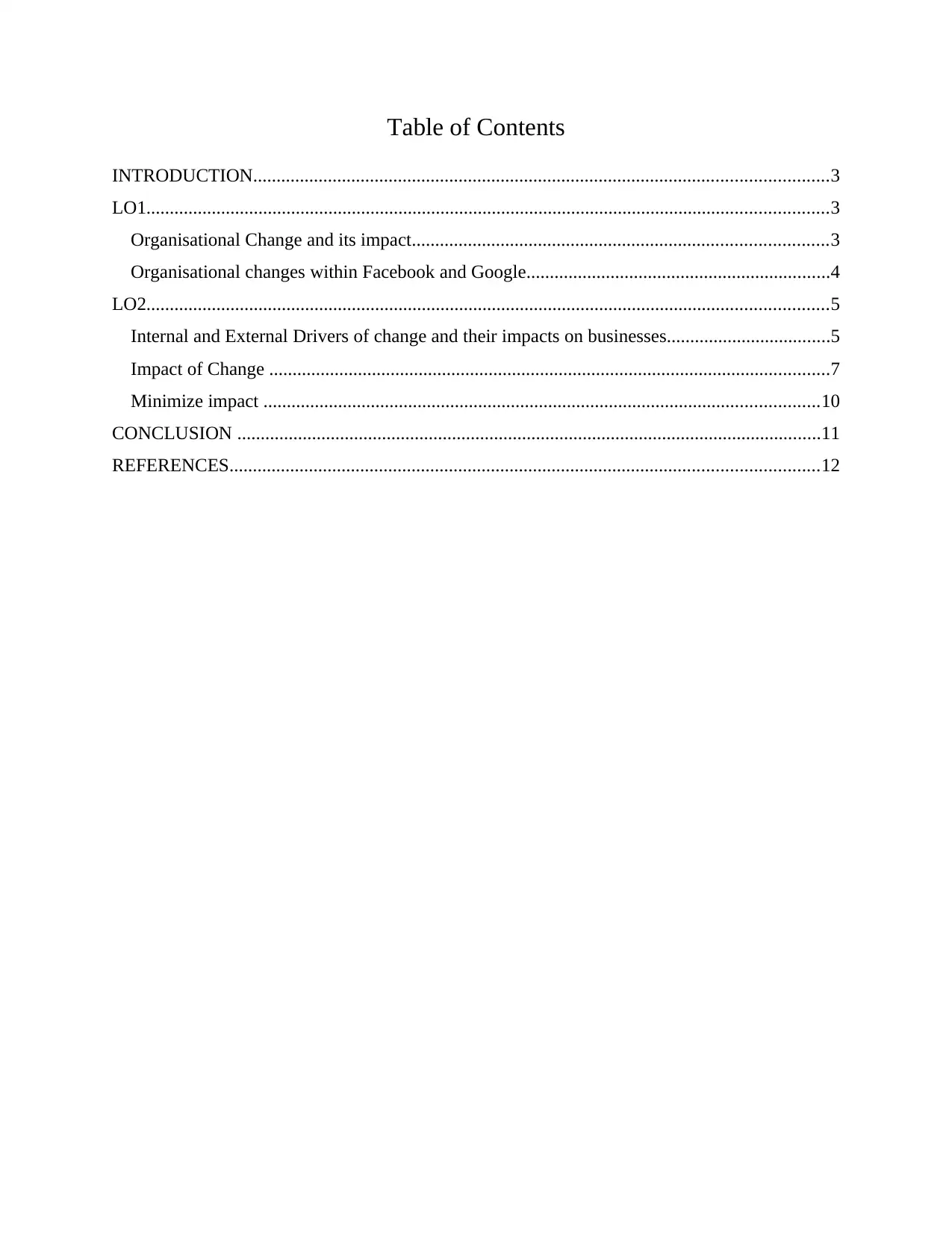
Table of Contents
INTRODUCTION...........................................................................................................................3
LO1..................................................................................................................................................3
Organisational Change and its impact.........................................................................................3
Organisational changes within Facebook and Google.................................................................4
LO2..................................................................................................................................................5
Internal and External Drivers of change and their impacts on businesses...................................5
Impact of Change ........................................................................................................................7
Minimize impact .......................................................................................................................10
CONCLUSION .............................................................................................................................11
REFERENCES..............................................................................................................................12
INTRODUCTION...........................................................................................................................3
LO1..................................................................................................................................................3
Organisational Change and its impact.........................................................................................3
Organisational changes within Facebook and Google.................................................................4
LO2..................................................................................................................................................5
Internal and External Drivers of change and their impacts on businesses...................................5
Impact of Change ........................................................................................................................7
Minimize impact .......................................................................................................................10
CONCLUSION .............................................................................................................................11
REFERENCES..............................................................................................................................12
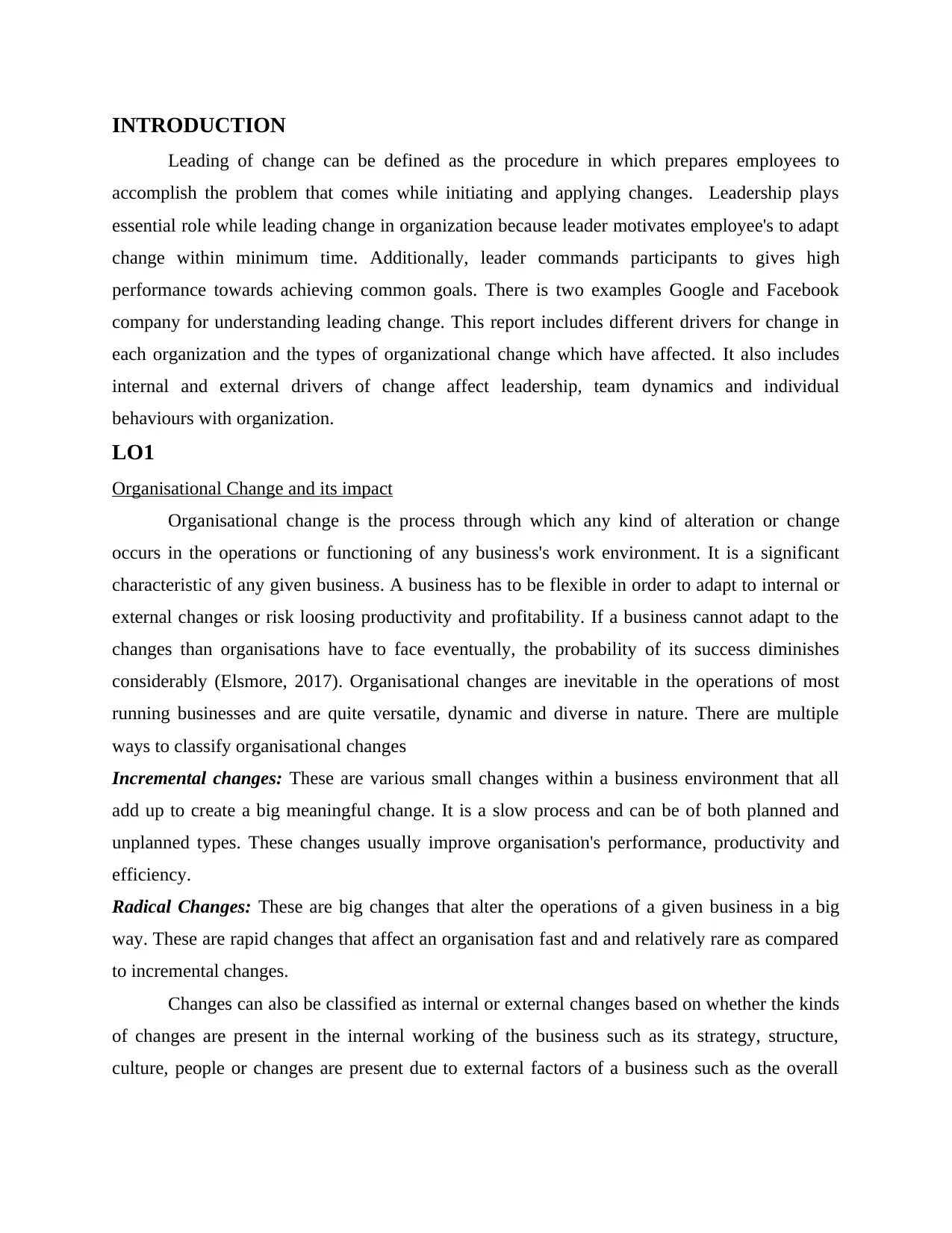
INTRODUCTION
Leading of change can be defined as the procedure in which prepares employees to
accomplish the problem that comes while initiating and applying changes. Leadership plays
essential role while leading change in organization because leader motivates employee's to adapt
change within minimum time. Additionally, leader commands participants to gives high
performance towards achieving common goals. There is two examples Google and Facebook
company for understanding leading change. This report includes different drivers for change in
each organization and the types of organizational change which have affected. It also includes
internal and external drivers of change affect leadership, team dynamics and individual
behaviours with organization.
LO1
Organisational Change and its impact
Organisational change is the process through which any kind of alteration or change
occurs in the operations or functioning of any business's work environment. It is a significant
characteristic of any given business. A business has to be flexible in order to adapt to internal or
external changes or risk loosing productivity and profitability. If a business cannot adapt to the
changes than organisations have to face eventually, the probability of its success diminishes
considerably (Elsmore, 2017). Organisational changes are inevitable in the operations of most
running businesses and are quite versatile, dynamic and diverse in nature. There are multiple
ways to classify organisational changes
Incremental changes: These are various small changes within a business environment that all
add up to create a big meaningful change. It is a slow process and can be of both planned and
unplanned types. These changes usually improve organisation's performance, productivity and
efficiency.
Radical Changes: These are big changes that alter the operations of a given business in a big
way. These are rapid changes that affect an organisation fast and and relatively rare as compared
to incremental changes.
Changes can also be classified as internal or external changes based on whether the kinds
of changes are present in the internal working of the business such as its strategy, structure,
culture, people or changes are present due to external factors of a business such as the overall
Leading of change can be defined as the procedure in which prepares employees to
accomplish the problem that comes while initiating and applying changes. Leadership plays
essential role while leading change in organization because leader motivates employee's to adapt
change within minimum time. Additionally, leader commands participants to gives high
performance towards achieving common goals. There is two examples Google and Facebook
company for understanding leading change. This report includes different drivers for change in
each organization and the types of organizational change which have affected. It also includes
internal and external drivers of change affect leadership, team dynamics and individual
behaviours with organization.
LO1
Organisational Change and its impact
Organisational change is the process through which any kind of alteration or change
occurs in the operations or functioning of any business's work environment. It is a significant
characteristic of any given business. A business has to be flexible in order to adapt to internal or
external changes or risk loosing productivity and profitability. If a business cannot adapt to the
changes than organisations have to face eventually, the probability of its success diminishes
considerably (Elsmore, 2017). Organisational changes are inevitable in the operations of most
running businesses and are quite versatile, dynamic and diverse in nature. There are multiple
ways to classify organisational changes
Incremental changes: These are various small changes within a business environment that all
add up to create a big meaningful change. It is a slow process and can be of both planned and
unplanned types. These changes usually improve organisation's performance, productivity and
efficiency.
Radical Changes: These are big changes that alter the operations of a given business in a big
way. These are rapid changes that affect an organisation fast and and relatively rare as compared
to incremental changes.
Changes can also be classified as internal or external changes based on whether the kinds
of changes are present in the internal working of the business such as its strategy, structure,
culture, people or changes are present due to external factors of a business such as the overall
⊘ This is a preview!⊘
Do you want full access?
Subscribe today to unlock all pages.

Trusted by 1+ million students worldwide
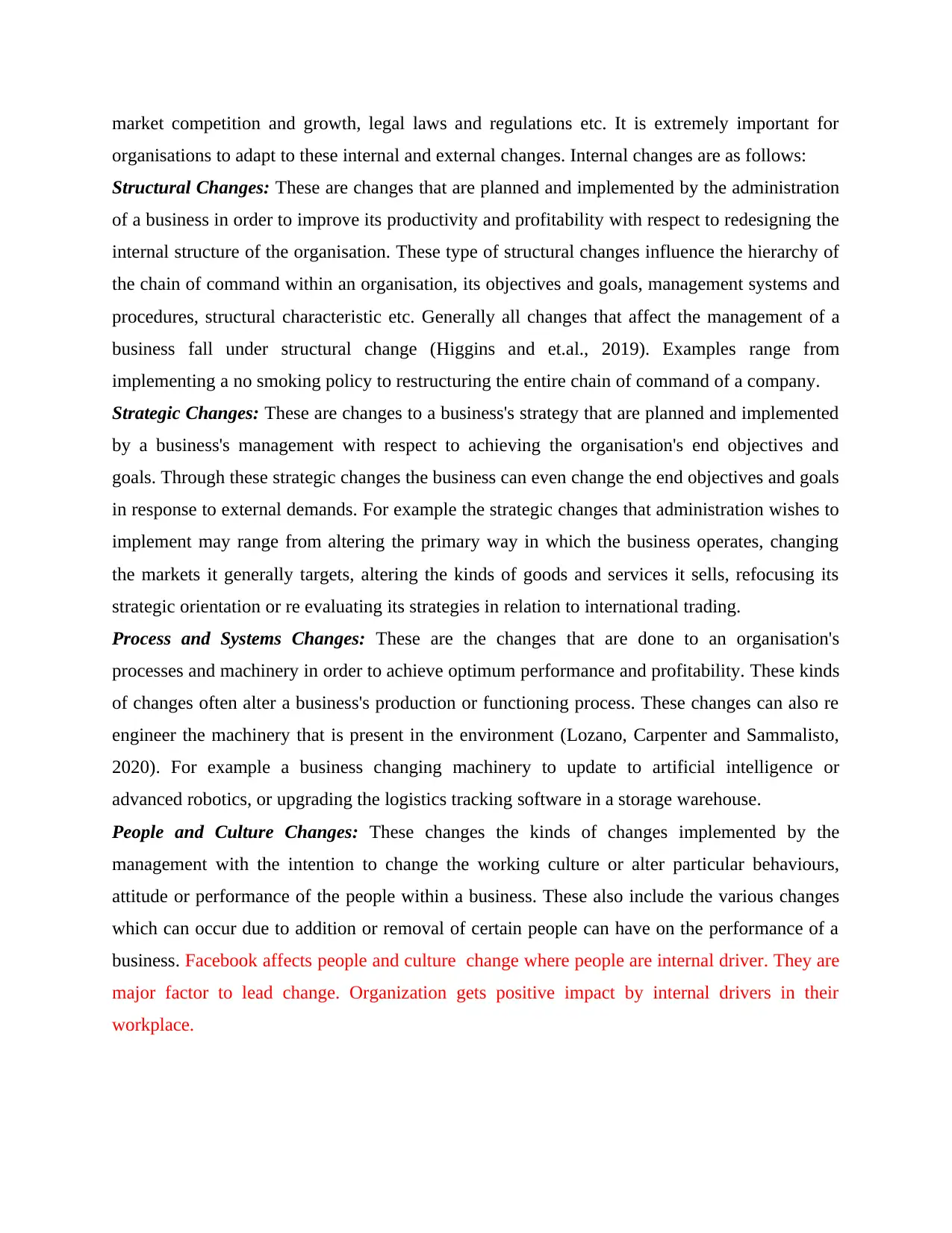
market competition and growth, legal laws and regulations etc. It is extremely important for
organisations to adapt to these internal and external changes. Internal changes are as follows:
Structural Changes: These are changes that are planned and implemented by the administration
of a business in order to improve its productivity and profitability with respect to redesigning the
internal structure of the organisation. These type of structural changes influence the hierarchy of
the chain of command within an organisation, its objectives and goals, management systems and
procedures, structural characteristic etc. Generally all changes that affect the management of a
business fall under structural change (Higgins and et.al., 2019). Examples range from
implementing a no smoking policy to restructuring the entire chain of command of a company.
Strategic Changes: These are changes to a business's strategy that are planned and implemented
by a business's management with respect to achieving the organisation's end objectives and
goals. Through these strategic changes the business can even change the end objectives and goals
in response to external demands. For example the strategic changes that administration wishes to
implement may range from altering the primary way in which the business operates, changing
the markets it generally targets, altering the kinds of goods and services it sells, refocusing its
strategic orientation or re evaluating its strategies in relation to international trading.
Process and Systems Changes: These are the changes that are done to an organisation's
processes and machinery in order to achieve optimum performance and profitability. These kinds
of changes often alter a business's production or functioning process. These changes can also re
engineer the machinery that is present in the environment (Lozano, Carpenter and Sammalisto,
2020). For example a business changing machinery to update to artificial intelligence or
advanced robotics, or upgrading the logistics tracking software in a storage warehouse.
People and Culture Changes: These changes the kinds of changes implemented by the
management with the intention to change the working culture or alter particular behaviours,
attitude or performance of the people within a business. These also include the various changes
which can occur due to addition or removal of certain people can have on the performance of a
business. Facebook affects people and culture change where people are internal driver. They are
major factor to lead change. Organization gets positive impact by internal drivers in their
workplace.
organisations to adapt to these internal and external changes. Internal changes are as follows:
Structural Changes: These are changes that are planned and implemented by the administration
of a business in order to improve its productivity and profitability with respect to redesigning the
internal structure of the organisation. These type of structural changes influence the hierarchy of
the chain of command within an organisation, its objectives and goals, management systems and
procedures, structural characteristic etc. Generally all changes that affect the management of a
business fall under structural change (Higgins and et.al., 2019). Examples range from
implementing a no smoking policy to restructuring the entire chain of command of a company.
Strategic Changes: These are changes to a business's strategy that are planned and implemented
by a business's management with respect to achieving the organisation's end objectives and
goals. Through these strategic changes the business can even change the end objectives and goals
in response to external demands. For example the strategic changes that administration wishes to
implement may range from altering the primary way in which the business operates, changing
the markets it generally targets, altering the kinds of goods and services it sells, refocusing its
strategic orientation or re evaluating its strategies in relation to international trading.
Process and Systems Changes: These are the changes that are done to an organisation's
processes and machinery in order to achieve optimum performance and profitability. These kinds
of changes often alter a business's production or functioning process. These changes can also re
engineer the machinery that is present in the environment (Lozano, Carpenter and Sammalisto,
2020). For example a business changing machinery to update to artificial intelligence or
advanced robotics, or upgrading the logistics tracking software in a storage warehouse.
People and Culture Changes: These changes the kinds of changes implemented by the
management with the intention to change the working culture or alter particular behaviours,
attitude or performance of the people within a business. These also include the various changes
which can occur due to addition or removal of certain people can have on the performance of a
business. Facebook affects people and culture change where people are internal driver. They are
major factor to lead change. Organization gets positive impact by internal drivers in their
workplace.
Paraphrase This Document
Need a fresh take? Get an instant paraphrase of this document with our AI Paraphraser
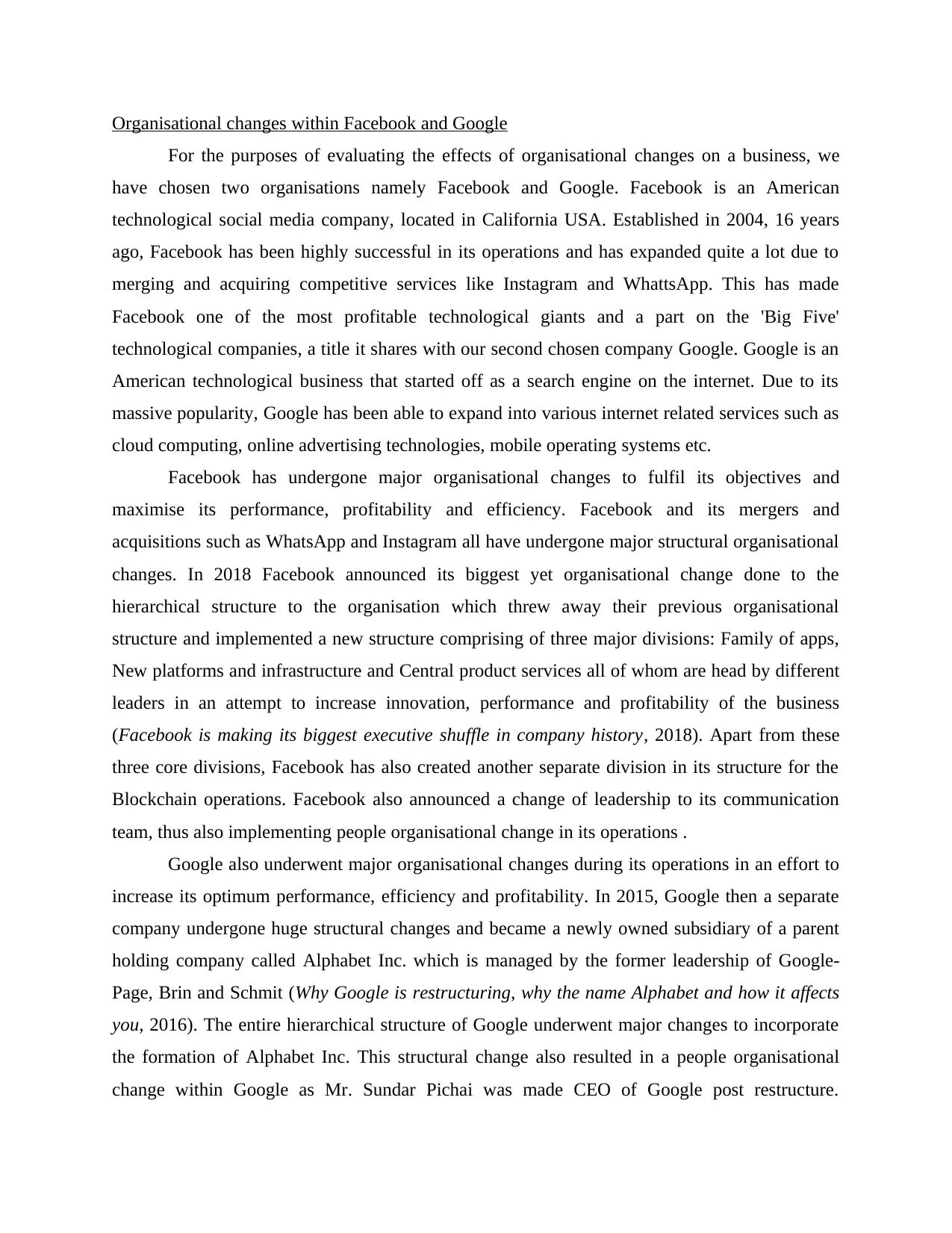
Organisational changes within Facebook and Google
For the purposes of evaluating the effects of organisational changes on a business, we
have chosen two organisations namely Facebook and Google. Facebook is an American
technological social media company, located in California USA. Established in 2004, 16 years
ago, Facebook has been highly successful in its operations and has expanded quite a lot due to
merging and acquiring competitive services like Instagram and WhattsApp. This has made
Facebook one of the most profitable technological giants and a part on the 'Big Five'
technological companies, a title it shares with our second chosen company Google. Google is an
American technological business that started off as a search engine on the internet. Due to its
massive popularity, Google has been able to expand into various internet related services such as
cloud computing, online advertising technologies, mobile operating systems etc.
Facebook has undergone major organisational changes to fulfil its objectives and
maximise its performance, profitability and efficiency. Facebook and its mergers and
acquisitions such as WhatsApp and Instagram all have undergone major structural organisational
changes. In 2018 Facebook announced its biggest yet organisational change done to the
hierarchical structure to the organisation which threw away their previous organisational
structure and implemented a new structure comprising of three major divisions: Family of apps,
New platforms and infrastructure and Central product services all of whom are head by different
leaders in an attempt to increase innovation, performance and profitability of the business
(Facebook is making its biggest executive shuffle in company history, 2018). Apart from these
three core divisions, Facebook has also created another separate division in its structure for the
Blockchain operations. Facebook also announced a change of leadership to its communication
team, thus also implementing people organisational change in its operations .
Google also underwent major organisational changes during its operations in an effort to
increase its optimum performance, efficiency and profitability. In 2015, Google then a separate
company undergone huge structural changes and became a newly owned subsidiary of a parent
holding company called Alphabet Inc. which is managed by the former leadership of Google-
Page, Brin and Schmit (Why Google is restructuring, why the name Alphabet and how it affects
you, 2016). The entire hierarchical structure of Google underwent major changes to incorporate
the formation of Alphabet Inc. This structural change also resulted in a people organisational
change within Google as Mr. Sundar Pichai was made CEO of Google post restructure.
For the purposes of evaluating the effects of organisational changes on a business, we
have chosen two organisations namely Facebook and Google. Facebook is an American
technological social media company, located in California USA. Established in 2004, 16 years
ago, Facebook has been highly successful in its operations and has expanded quite a lot due to
merging and acquiring competitive services like Instagram and WhattsApp. This has made
Facebook one of the most profitable technological giants and a part on the 'Big Five'
technological companies, a title it shares with our second chosen company Google. Google is an
American technological business that started off as a search engine on the internet. Due to its
massive popularity, Google has been able to expand into various internet related services such as
cloud computing, online advertising technologies, mobile operating systems etc.
Facebook has undergone major organisational changes to fulfil its objectives and
maximise its performance, profitability and efficiency. Facebook and its mergers and
acquisitions such as WhatsApp and Instagram all have undergone major structural organisational
changes. In 2018 Facebook announced its biggest yet organisational change done to the
hierarchical structure to the organisation which threw away their previous organisational
structure and implemented a new structure comprising of three major divisions: Family of apps,
New platforms and infrastructure and Central product services all of whom are head by different
leaders in an attempt to increase innovation, performance and profitability of the business
(Facebook is making its biggest executive shuffle in company history, 2018). Apart from these
three core divisions, Facebook has also created another separate division in its structure for the
Blockchain operations. Facebook also announced a change of leadership to its communication
team, thus also implementing people organisational change in its operations .
Google also underwent major organisational changes during its operations in an effort to
increase its optimum performance, efficiency and profitability. In 2015, Google then a separate
company undergone huge structural changes and became a newly owned subsidiary of a parent
holding company called Alphabet Inc. which is managed by the former leadership of Google-
Page, Brin and Schmit (Why Google is restructuring, why the name Alphabet and how it affects
you, 2016). The entire hierarchical structure of Google underwent major changes to incorporate
the formation of Alphabet Inc. This structural change also resulted in a people organisational
change within Google as Mr. Sundar Pichai was made CEO of Google post restructure.
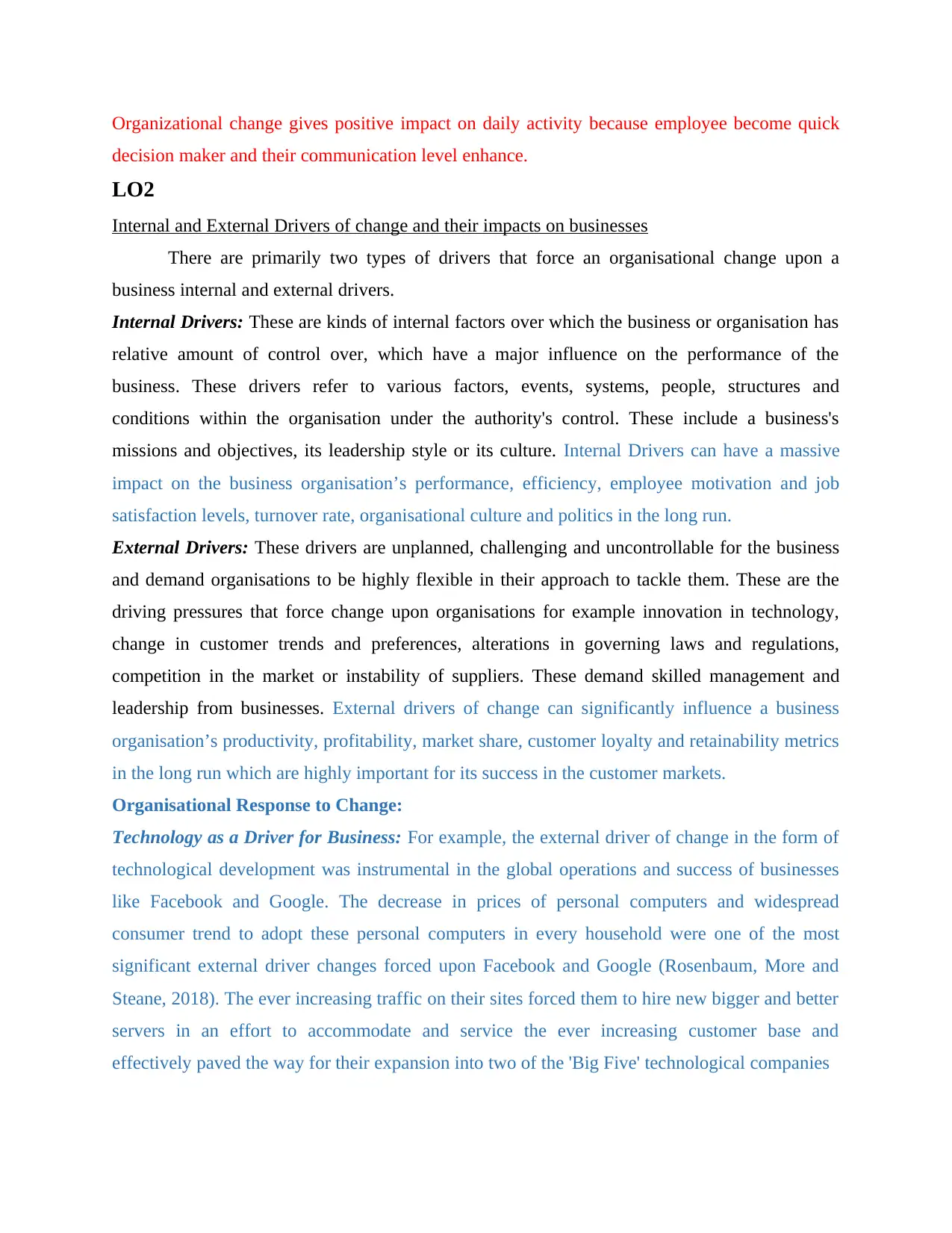
Organizational change gives positive impact on daily activity because employee become quick
decision maker and their communication level enhance.
LO2
Internal and External Drivers of change and their impacts on businesses
There are primarily two types of drivers that force an organisational change upon a
business internal and external drivers.
Internal Drivers: These are kinds of internal factors over which the business or organisation has
relative amount of control over, which have a major influence on the performance of the
business. These drivers refer to various factors, events, systems, people, structures and
conditions within the organisation under the authority's control. These include a business's
missions and objectives, its leadership style or its culture. Internal Drivers can have a massive
impact on the business organisation’s performance, efficiency, employee motivation and job
satisfaction levels, turnover rate, organisational culture and politics in the long run.
External Drivers: These drivers are unplanned, challenging and uncontrollable for the business
and demand organisations to be highly flexible in their approach to tackle them. These are the
driving pressures that force change upon organisations for example innovation in technology,
change in customer trends and preferences, alterations in governing laws and regulations,
competition in the market or instability of suppliers. These demand skilled management and
leadership from businesses. External drivers of change can significantly influence a business
organisation’s productivity, profitability, market share, customer loyalty and retainability metrics
in the long run which are highly important for its success in the customer markets.
Organisational Response to Change:
Technology as a Driver for Business: For example, the external driver of change in the form of
technological development was instrumental in the global operations and success of businesses
like Facebook and Google. The decrease in prices of personal computers and widespread
consumer trend to adopt these personal computers in every household were one of the most
significant external driver changes forced upon Facebook and Google (Rosenbaum, More and
Steane, 2018). The ever increasing traffic on their sites forced them to hire new bigger and better
servers in an effort to accommodate and service the ever increasing customer base and
effectively paved the way for their expansion into two of the 'Big Five' technological companies
decision maker and their communication level enhance.
LO2
Internal and External Drivers of change and their impacts on businesses
There are primarily two types of drivers that force an organisational change upon a
business internal and external drivers.
Internal Drivers: These are kinds of internal factors over which the business or organisation has
relative amount of control over, which have a major influence on the performance of the
business. These drivers refer to various factors, events, systems, people, structures and
conditions within the organisation under the authority's control. These include a business's
missions and objectives, its leadership style or its culture. Internal Drivers can have a massive
impact on the business organisation’s performance, efficiency, employee motivation and job
satisfaction levels, turnover rate, organisational culture and politics in the long run.
External Drivers: These drivers are unplanned, challenging and uncontrollable for the business
and demand organisations to be highly flexible in their approach to tackle them. These are the
driving pressures that force change upon organisations for example innovation in technology,
change in customer trends and preferences, alterations in governing laws and regulations,
competition in the market or instability of suppliers. These demand skilled management and
leadership from businesses. External drivers of change can significantly influence a business
organisation’s productivity, profitability, market share, customer loyalty and retainability metrics
in the long run which are highly important for its success in the customer markets.
Organisational Response to Change:
Technology as a Driver for Business: For example, the external driver of change in the form of
technological development was instrumental in the global operations and success of businesses
like Facebook and Google. The decrease in prices of personal computers and widespread
consumer trend to adopt these personal computers in every household were one of the most
significant external driver changes forced upon Facebook and Google (Rosenbaum, More and
Steane, 2018). The ever increasing traffic on their sites forced them to hire new bigger and better
servers in an effort to accommodate and service the ever increasing customer base and
effectively paved the way for their expansion into two of the 'Big Five' technological companies
⊘ This is a preview!⊘
Do you want full access?
Subscribe today to unlock all pages.

Trusted by 1+ million students worldwide
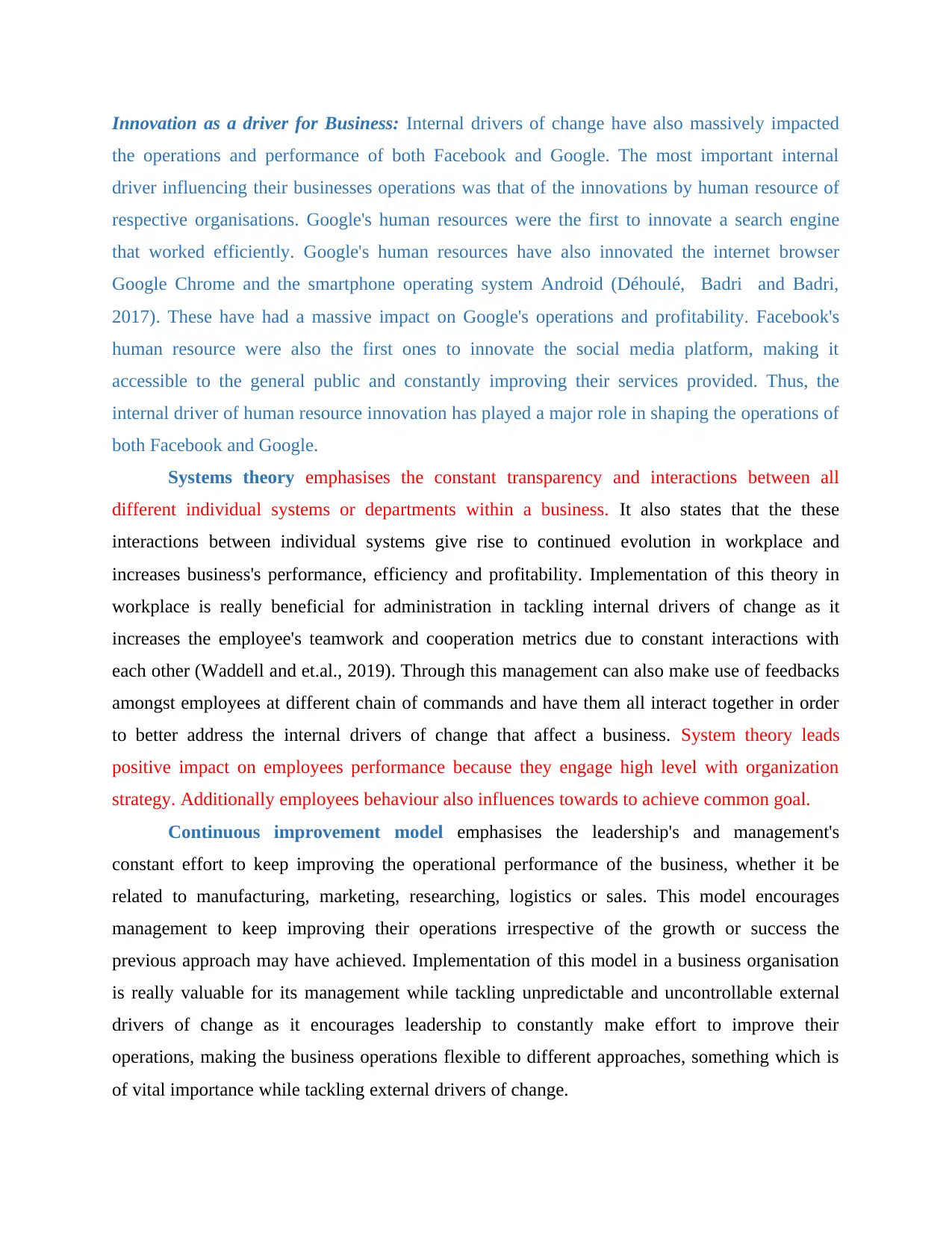
Innovation as a driver for Business: Internal drivers of change have also massively impacted
the operations and performance of both Facebook and Google. The most important internal
driver influencing their businesses operations was that of the innovations by human resource of
respective organisations. Google's human resources were the first to innovate a search engine
that worked efficiently. Google's human resources have also innovated the internet browser
Google Chrome and the smartphone operating system Android (Déhoulé, Badri and Badri,
2017). These have had a massive impact on Google's operations and profitability. Facebook's
human resource were also the first ones to innovate the social media platform, making it
accessible to the general public and constantly improving their services provided. Thus, the
internal driver of human resource innovation has played a major role in shaping the operations of
both Facebook and Google.
Systems theory emphasises the constant transparency and interactions between all
different individual systems or departments within a business. It also states that the these
interactions between individual systems give rise to continued evolution in workplace and
increases business's performance, efficiency and profitability. Implementation of this theory in
workplace is really beneficial for administration in tackling internal drivers of change as it
increases the employee's teamwork and cooperation metrics due to constant interactions with
each other (Waddell and et.al., 2019). Through this management can also make use of feedbacks
amongst employees at different chain of commands and have them all interact together in order
to better address the internal drivers of change that affect a business. System theory leads
positive impact on employees performance because they engage high level with organization
strategy. Additionally employees behaviour also influences towards to achieve common goal.
Continuous improvement model emphasises the leadership's and management's
constant effort to keep improving the operational performance of the business, whether it be
related to manufacturing, marketing, researching, logistics or sales. This model encourages
management to keep improving their operations irrespective of the growth or success the
previous approach may have achieved. Implementation of this model in a business organisation
is really valuable for its management while tackling unpredictable and uncontrollable external
drivers of change as it encourages leadership to constantly make effort to improve their
operations, making the business operations flexible to different approaches, something which is
of vital importance while tackling external drivers of change.
the operations and performance of both Facebook and Google. The most important internal
driver influencing their businesses operations was that of the innovations by human resource of
respective organisations. Google's human resources were the first to innovate a search engine
that worked efficiently. Google's human resources have also innovated the internet browser
Google Chrome and the smartphone operating system Android (Déhoulé, Badri and Badri,
2017). These have had a massive impact on Google's operations and profitability. Facebook's
human resource were also the first ones to innovate the social media platform, making it
accessible to the general public and constantly improving their services provided. Thus, the
internal driver of human resource innovation has played a major role in shaping the operations of
both Facebook and Google.
Systems theory emphasises the constant transparency and interactions between all
different individual systems or departments within a business. It also states that the these
interactions between individual systems give rise to continued evolution in workplace and
increases business's performance, efficiency and profitability. Implementation of this theory in
workplace is really beneficial for administration in tackling internal drivers of change as it
increases the employee's teamwork and cooperation metrics due to constant interactions with
each other (Waddell and et.al., 2019). Through this management can also make use of feedbacks
amongst employees at different chain of commands and have them all interact together in order
to better address the internal drivers of change that affect a business. System theory leads
positive impact on employees performance because they engage high level with organization
strategy. Additionally employees behaviour also influences towards to achieve common goal.
Continuous improvement model emphasises the leadership's and management's
constant effort to keep improving the operational performance of the business, whether it be
related to manufacturing, marketing, researching, logistics or sales. This model encourages
management to keep improving their operations irrespective of the growth or success the
previous approach may have achieved. Implementation of this model in a business organisation
is really valuable for its management while tackling unpredictable and uncontrollable external
drivers of change as it encourages leadership to constantly make effort to improve their
operations, making the business operations flexible to different approaches, something which is
of vital importance while tackling external drivers of change.
Paraphrase This Document
Need a fresh take? Get an instant paraphrase of this document with our AI Paraphraser
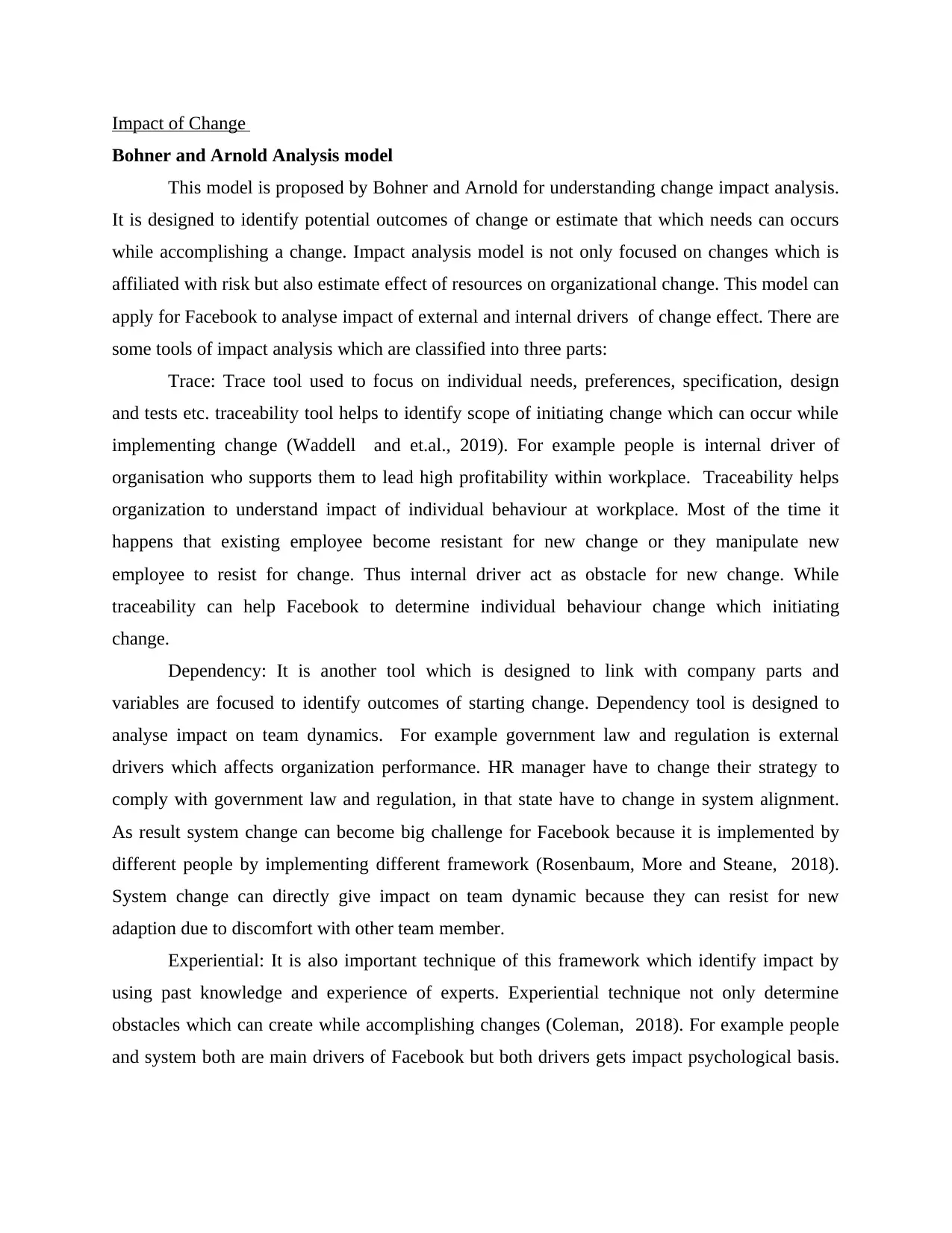
Impact of Change
Bohner and Arnold Analysis model
This model is proposed by Bohner and Arnold for understanding change impact analysis.
It is designed to identify potential outcomes of change or estimate that which needs can occurs
while accomplishing a change. Impact analysis model is not only focused on changes which is
affiliated with risk but also estimate effect of resources on organizational change. This model can
apply for Facebook to analyse impact of external and internal drivers of change effect. There are
some tools of impact analysis which are classified into three parts:
Trace: Trace tool used to focus on individual needs, preferences, specification, design
and tests etc. traceability tool helps to identify scope of initiating change which can occur while
implementing change (Waddell and et.al., 2019). For example people is internal driver of
organisation who supports them to lead high profitability within workplace. Traceability helps
organization to understand impact of individual behaviour at workplace. Most of the time it
happens that existing employee become resistant for new change or they manipulate new
employee to resist for change. Thus internal driver act as obstacle for new change. While
traceability can help Facebook to determine individual behaviour change which initiating
change.
Dependency: It is another tool which is designed to link with company parts and
variables are focused to identify outcomes of starting change. Dependency tool is designed to
analyse impact on team dynamics. For example government law and regulation is external
drivers which affects organization performance. HR manager have to change their strategy to
comply with government law and regulation, in that state have to change in system alignment.
As result system change can become big challenge for Facebook because it is implemented by
different people by implementing different framework (Rosenbaum, More and Steane, 2018).
System change can directly give impact on team dynamic because they can resist for new
adaption due to discomfort with other team member.
Experiential: It is also important technique of this framework which identify impact by
using past knowledge and experience of experts. Experiential technique not only determine
obstacles which can create while accomplishing changes (Coleman, 2018). For example people
and system both are main drivers of Facebook but both drivers gets impact psychological basis.
Bohner and Arnold Analysis model
This model is proposed by Bohner and Arnold for understanding change impact analysis.
It is designed to identify potential outcomes of change or estimate that which needs can occurs
while accomplishing a change. Impact analysis model is not only focused on changes which is
affiliated with risk but also estimate effect of resources on organizational change. This model can
apply for Facebook to analyse impact of external and internal drivers of change effect. There are
some tools of impact analysis which are classified into three parts:
Trace: Trace tool used to focus on individual needs, preferences, specification, design
and tests etc. traceability tool helps to identify scope of initiating change which can occur while
implementing change (Waddell and et.al., 2019). For example people is internal driver of
organisation who supports them to lead high profitability within workplace. Traceability helps
organization to understand impact of individual behaviour at workplace. Most of the time it
happens that existing employee become resistant for new change or they manipulate new
employee to resist for change. Thus internal driver act as obstacle for new change. While
traceability can help Facebook to determine individual behaviour change which initiating
change.
Dependency: It is another tool which is designed to link with company parts and
variables are focused to identify outcomes of starting change. Dependency tool is designed to
analyse impact on team dynamics. For example government law and regulation is external
drivers which affects organization performance. HR manager have to change their strategy to
comply with government law and regulation, in that state have to change in system alignment.
As result system change can become big challenge for Facebook because it is implemented by
different people by implementing different framework (Rosenbaum, More and Steane, 2018).
System change can directly give impact on team dynamic because they can resist for new
adaption due to discomfort with other team member.
Experiential: It is also important technique of this framework which identify impact by
using past knowledge and experience of experts. Experiential technique not only determine
obstacles which can create while accomplishing changes (Coleman, 2018). For example people
and system both are main drivers of Facebook but both drivers gets impact psychological basis.
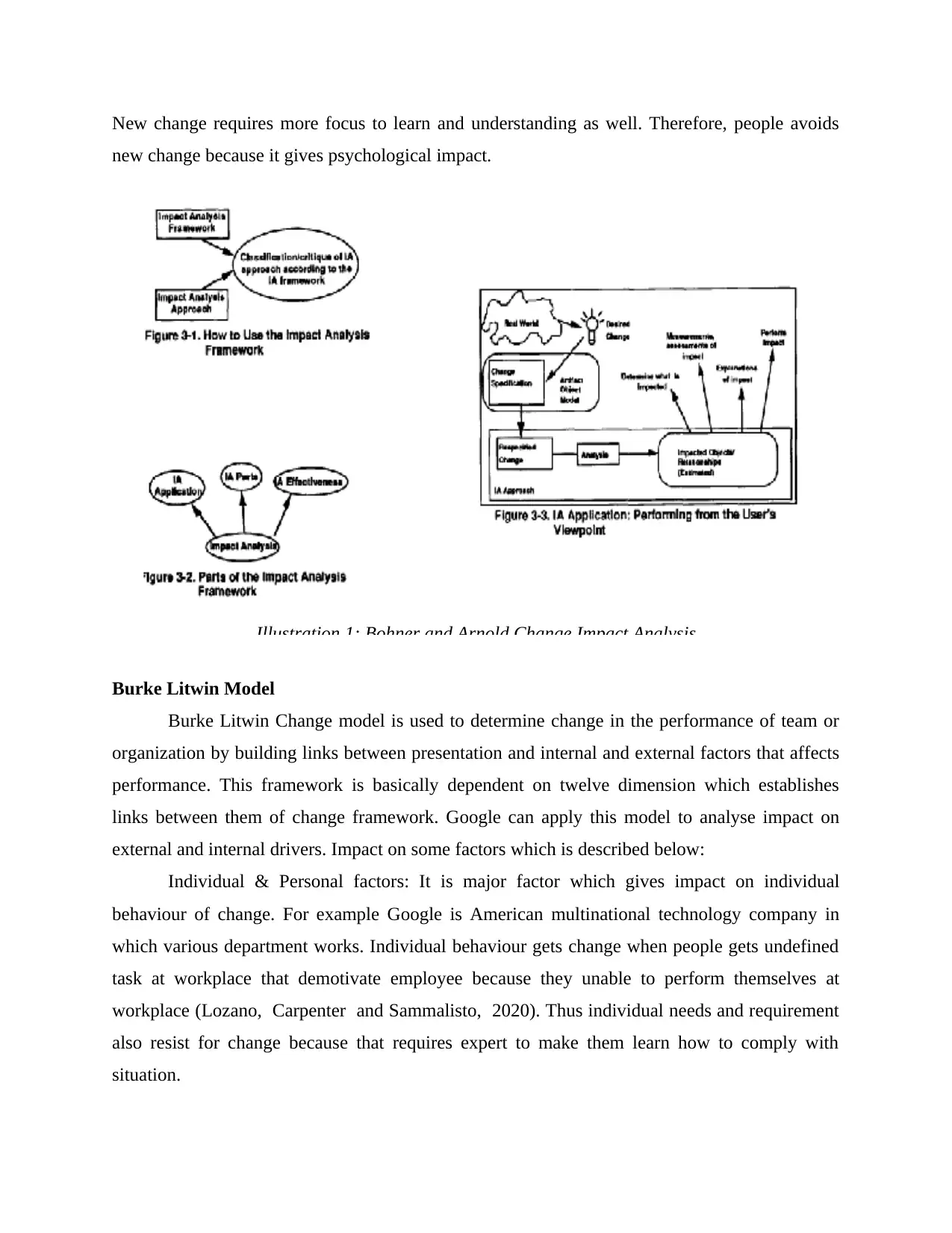
New change requires more focus to learn and understanding as well. Therefore, people avoids
new change because it gives psychological impact.
Burke Litwin Model
Burke Litwin Change model is used to determine change in the performance of team or
organization by building links between presentation and internal and external factors that affects
performance. This framework is basically dependent on twelve dimension which establishes
links between them of change framework. Google can apply this model to analyse impact on
external and internal drivers. Impact on some factors which is described below:
Individual & Personal factors: It is major factor which gives impact on individual
behaviour of change. For example Google is American multinational technology company in
which various department works. Individual behaviour gets change when people gets undefined
task at workplace that demotivate employee because they unable to perform themselves at
workplace (Lozano, Carpenter and Sammalisto, 2020). Thus individual needs and requirement
also resist for change because that requires expert to make them learn how to comply with
situation.
Illustration 1: Bohner and Arnold Change Impact Analysis
new change because it gives psychological impact.
Burke Litwin Model
Burke Litwin Change model is used to determine change in the performance of team or
organization by building links between presentation and internal and external factors that affects
performance. This framework is basically dependent on twelve dimension which establishes
links between them of change framework. Google can apply this model to analyse impact on
external and internal drivers. Impact on some factors which is described below:
Individual & Personal factors: It is major factor which gives impact on individual
behaviour of change. For example Google is American multinational technology company in
which various department works. Individual behaviour gets change when people gets undefined
task at workplace that demotivate employee because they unable to perform themselves at
workplace (Lozano, Carpenter and Sammalisto, 2020). Thus individual needs and requirement
also resist for change because that requires expert to make them learn how to comply with
situation.
Illustration 1: Bohner and Arnold Change Impact Analysis
⊘ This is a preview!⊘
Do you want full access?
Subscribe today to unlock all pages.

Trusted by 1+ million students worldwide
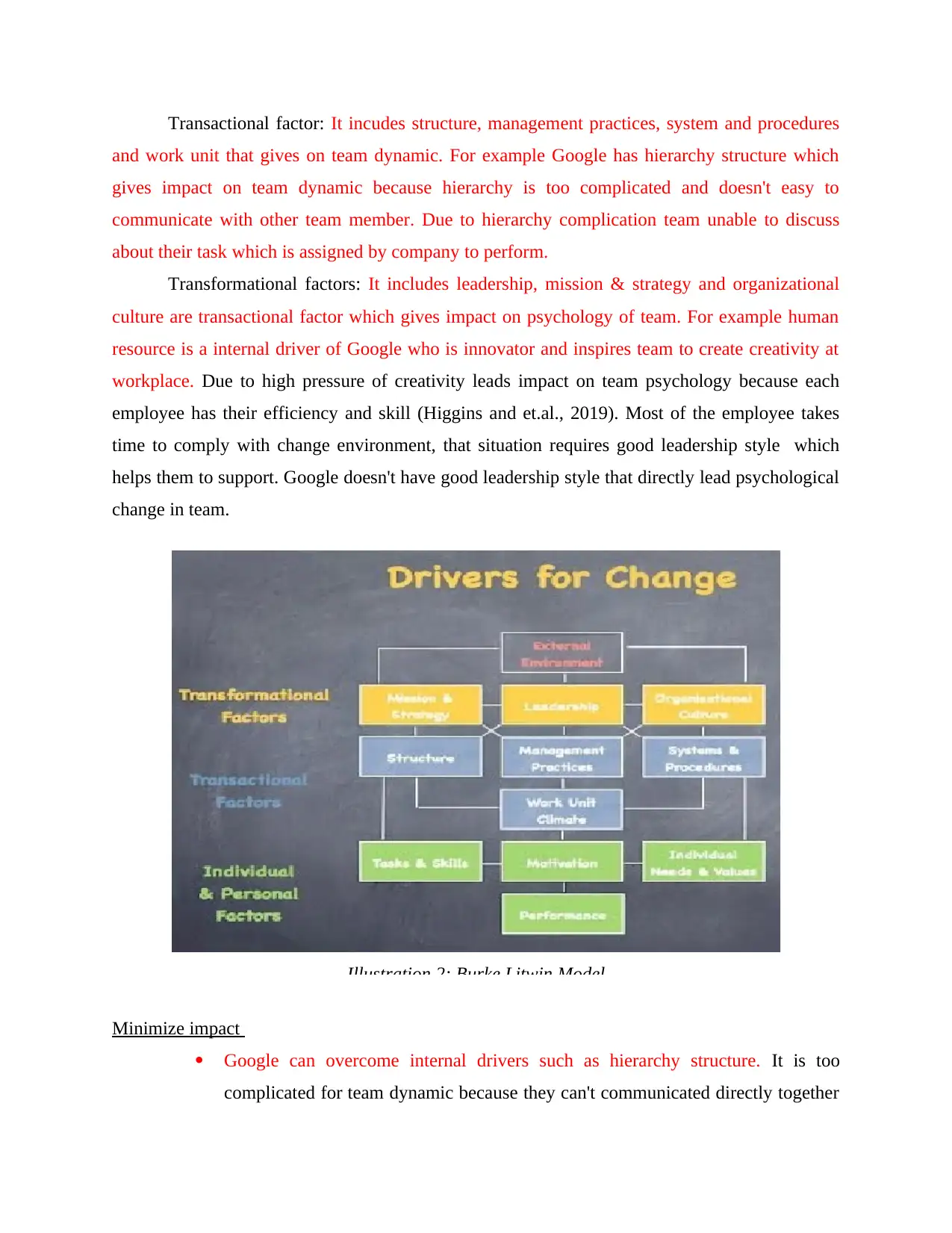
Transactional factor: It incudes structure, management practices, system and procedures
and work unit that gives on team dynamic. For example Google has hierarchy structure which
gives impact on team dynamic because hierarchy is too complicated and doesn't easy to
communicate with other team member. Due to hierarchy complication team unable to discuss
about their task which is assigned by company to perform.
Transformational factors: It includes leadership, mission & strategy and organizational
culture are transactional factor which gives impact on psychology of team. For example human
resource is a internal driver of Google who is innovator and inspires team to create creativity at
workplace. Due to high pressure of creativity leads impact on team psychology because each
employee has their efficiency and skill (Higgins and et.al., 2019). Most of the employee takes
time to comply with change environment, that situation requires good leadership style which
helps them to support. Google doesn't have good leadership style that directly lead psychological
change in team.
Minimize impact
Google can overcome internal drivers such as hierarchy structure. It is too
complicated for team dynamic because they can't communicated directly together
Illustration 2: Burke Litwin Model
and work unit that gives on team dynamic. For example Google has hierarchy structure which
gives impact on team dynamic because hierarchy is too complicated and doesn't easy to
communicate with other team member. Due to hierarchy complication team unable to discuss
about their task which is assigned by company to perform.
Transformational factors: It includes leadership, mission & strategy and organizational
culture are transactional factor which gives impact on psychology of team. For example human
resource is a internal driver of Google who is innovator and inspires team to create creativity at
workplace. Due to high pressure of creativity leads impact on team psychology because each
employee has their efficiency and skill (Higgins and et.al., 2019). Most of the employee takes
time to comply with change environment, that situation requires good leadership style which
helps them to support. Google doesn't have good leadership style that directly lead psychological
change in team.
Minimize impact
Google can overcome internal drivers such as hierarchy structure. It is too
complicated for team dynamic because they can't communicated directly together
Illustration 2: Burke Litwin Model
Paraphrase This Document
Need a fresh take? Get an instant paraphrase of this document with our AI Paraphraser
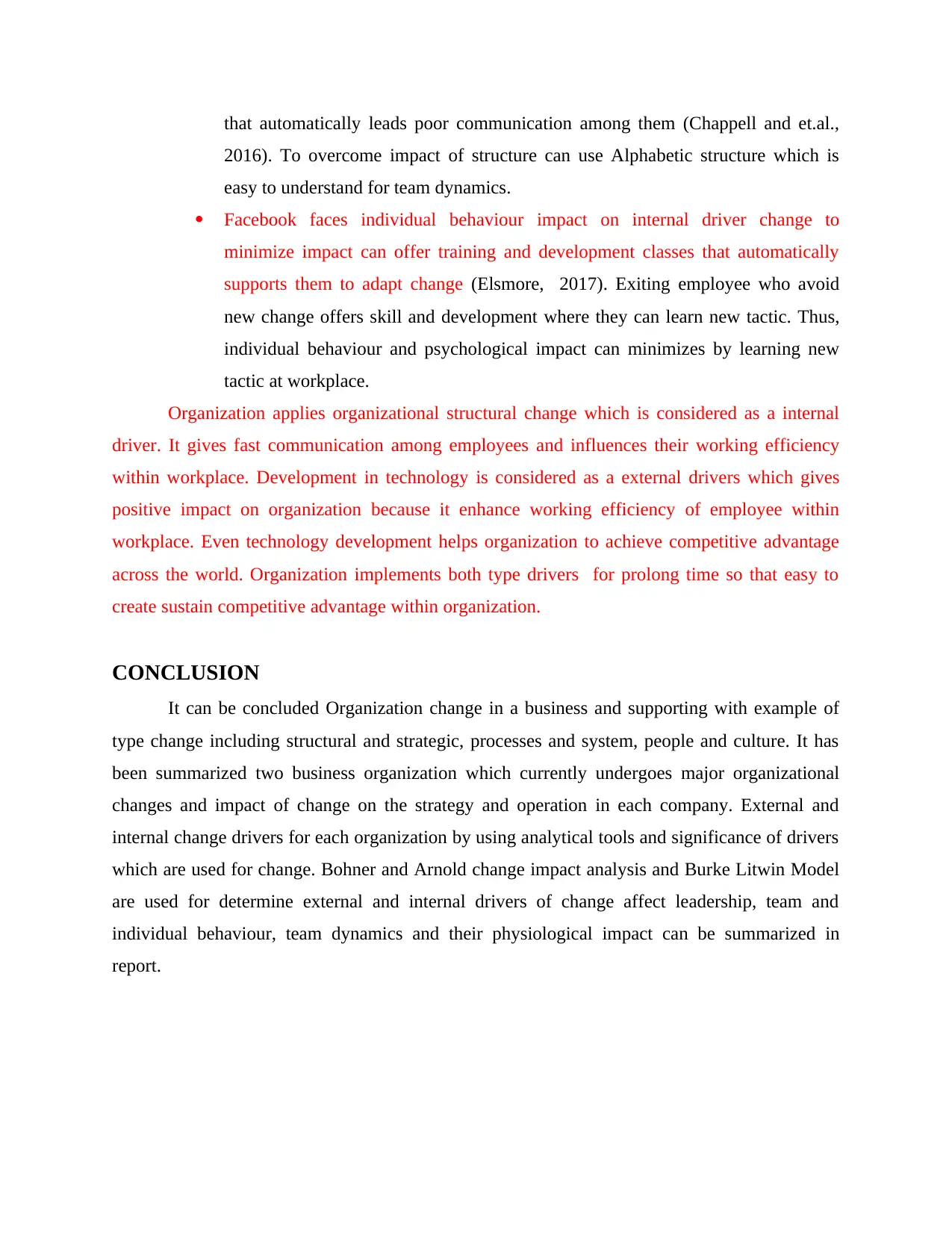
that automatically leads poor communication among them (Chappell and et.al.,
2016). To overcome impact of structure can use Alphabetic structure which is
easy to understand for team dynamics.
Facebook faces individual behaviour impact on internal driver change to
minimize impact can offer training and development classes that automatically
supports them to adapt change (Elsmore, 2017). Exiting employee who avoid
new change offers skill and development where they can learn new tactic. Thus,
individual behaviour and psychological impact can minimizes by learning new
tactic at workplace.
Organization applies organizational structural change which is considered as a internal
driver. It gives fast communication among employees and influences their working efficiency
within workplace. Development in technology is considered as a external drivers which gives
positive impact on organization because it enhance working efficiency of employee within
workplace. Even technology development helps organization to achieve competitive advantage
across the world. Organization implements both type drivers for prolong time so that easy to
create sustain competitive advantage within organization.
CONCLUSION
It can be concluded Organization change in a business and supporting with example of
type change including structural and strategic, processes and system, people and culture. It has
been summarized two business organization which currently undergoes major organizational
changes and impact of change on the strategy and operation in each company. External and
internal change drivers for each organization by using analytical tools and significance of drivers
which are used for change. Bohner and Arnold change impact analysis and Burke Litwin Model
are used for determine external and internal drivers of change affect leadership, team and
individual behaviour, team dynamics and their physiological impact can be summarized in
report.
2016). To overcome impact of structure can use Alphabetic structure which is
easy to understand for team dynamics.
Facebook faces individual behaviour impact on internal driver change to
minimize impact can offer training and development classes that automatically
supports them to adapt change (Elsmore, 2017). Exiting employee who avoid
new change offers skill and development where they can learn new tactic. Thus,
individual behaviour and psychological impact can minimizes by learning new
tactic at workplace.
Organization applies organizational structural change which is considered as a internal
driver. It gives fast communication among employees and influences their working efficiency
within workplace. Development in technology is considered as a external drivers which gives
positive impact on organization because it enhance working efficiency of employee within
workplace. Even technology development helps organization to achieve competitive advantage
across the world. Organization implements both type drivers for prolong time so that easy to
create sustain competitive advantage within organization.
CONCLUSION
It can be concluded Organization change in a business and supporting with example of
type change including structural and strategic, processes and system, people and culture. It has
been summarized two business organization which currently undergoes major organizational
changes and impact of change on the strategy and operation in each company. External and
internal change drivers for each organization by using analytical tools and significance of drivers
which are used for change. Bohner and Arnold change impact analysis and Burke Litwin Model
are used for determine external and internal drivers of change affect leadership, team and
individual behaviour, team dynamics and their physiological impact can be summarized in
report.
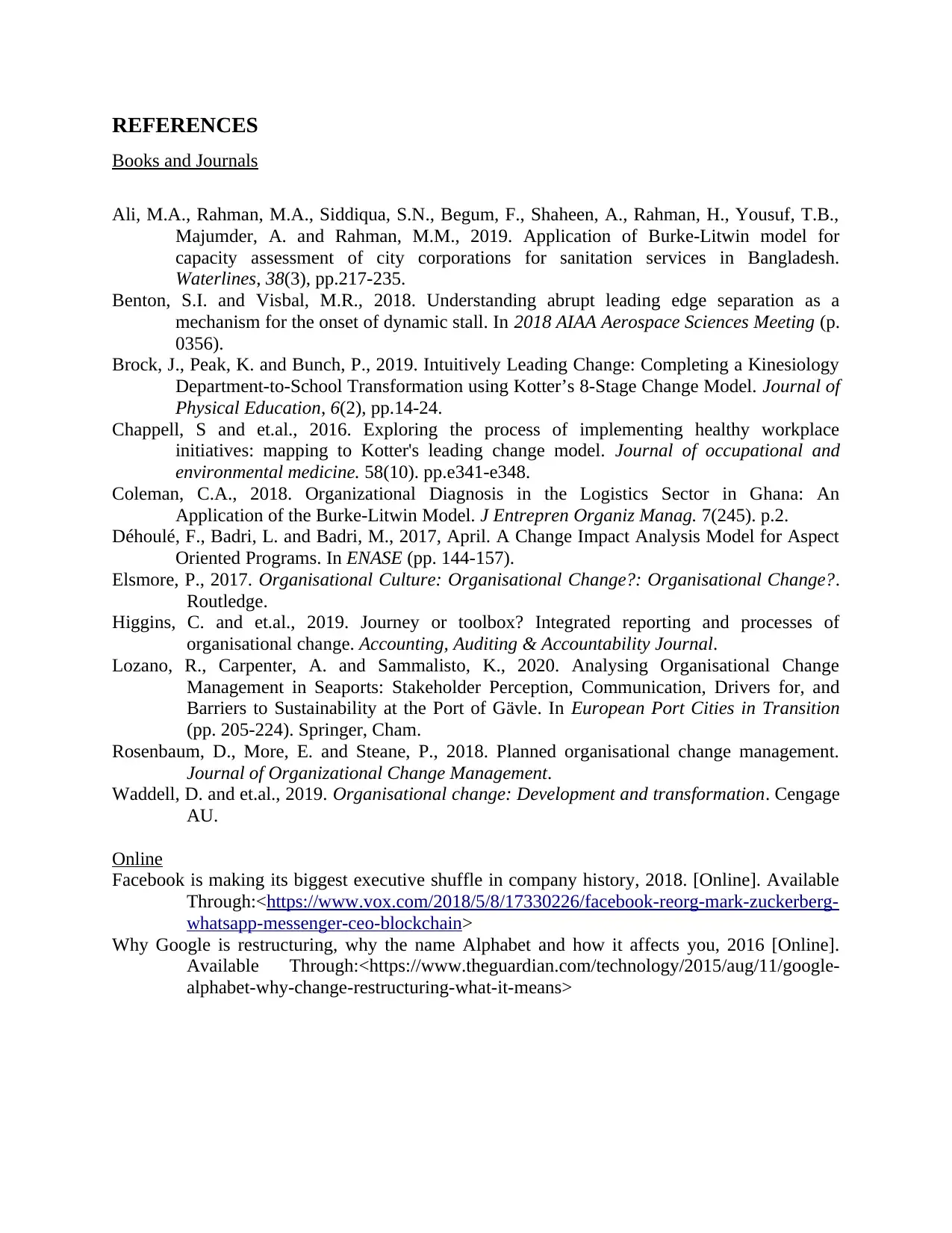
REFERENCES
Books and Journals
Ali, M.A., Rahman, M.A., Siddiqua, S.N., Begum, F., Shaheen, A., Rahman, H., Yousuf, T.B.,
Majumder, A. and Rahman, M.M., 2019. Application of Burke-Litwin model for
capacity assessment of city corporations for sanitation services in Bangladesh.
Waterlines, 38(3), pp.217-235.
Benton, S.I. and Visbal, M.R., 2018. Understanding abrupt leading edge separation as a
mechanism for the onset of dynamic stall. In 2018 AIAA Aerospace Sciences Meeting (p.
0356).
Brock, J., Peak, K. and Bunch, P., 2019. Intuitively Leading Change: Completing a Kinesiology
Department-to-School Transformation using Kotter’s 8-Stage Change Model. Journal of
Physical Education, 6(2), pp.14-24.
Chappell, S and et.al., 2016. Exploring the process of implementing healthy workplace
initiatives: mapping to Kotter's leading change model. Journal of occupational and
environmental medicine. 58(10). pp.e341-e348.
Coleman, C.A., 2018. Organizational Diagnosis in the Logistics Sector in Ghana: An
Application of the Burke-Litwin Model. J Entrepren Organiz Manag. 7(245). p.2.
Déhoulé, F., Badri, L. and Badri, M., 2017, April. A Change Impact Analysis Model for Aspect
Oriented Programs. In ENASE (pp. 144-157).
Elsmore, P., 2017. Organisational Culture: Organisational Change?: Organisational Change?.
Routledge.
Higgins, C. and et.al., 2019. Journey or toolbox? Integrated reporting and processes of
organisational change. Accounting, Auditing & Accountability Journal.
Lozano, R., Carpenter, A. and Sammalisto, K., 2020. Analysing Organisational Change
Management in Seaports: Stakeholder Perception, Communication, Drivers for, and
Barriers to Sustainability at the Port of Gävle. In European Port Cities in Transition
(pp. 205-224). Springer, Cham.
Rosenbaum, D., More, E. and Steane, P., 2018. Planned organisational change management.
Journal of Organizational Change Management.
Waddell, D. and et.al., 2019. Organisational change: Development and transformation. Cengage
AU.
Online
Facebook is making its biggest executive shuffle in company history, 2018. [Online]. Available
Through:<https://www.vox.com/2018/5/8/17330226/facebook-reorg-mark-zuckerberg-
whatsapp-messenger-ceo-blockchain>
Why Google is restructuring, why the name Alphabet and how it affects you, 2016 [Online].
Available Through:<https://www.theguardian.com/technology/2015/aug/11/google-
alphabet-why-change-restructuring-what-it-means>
Books and Journals
Ali, M.A., Rahman, M.A., Siddiqua, S.N., Begum, F., Shaheen, A., Rahman, H., Yousuf, T.B.,
Majumder, A. and Rahman, M.M., 2019. Application of Burke-Litwin model for
capacity assessment of city corporations for sanitation services in Bangladesh.
Waterlines, 38(3), pp.217-235.
Benton, S.I. and Visbal, M.R., 2018. Understanding abrupt leading edge separation as a
mechanism for the onset of dynamic stall. In 2018 AIAA Aerospace Sciences Meeting (p.
0356).
Brock, J., Peak, K. and Bunch, P., 2019. Intuitively Leading Change: Completing a Kinesiology
Department-to-School Transformation using Kotter’s 8-Stage Change Model. Journal of
Physical Education, 6(2), pp.14-24.
Chappell, S and et.al., 2016. Exploring the process of implementing healthy workplace
initiatives: mapping to Kotter's leading change model. Journal of occupational and
environmental medicine. 58(10). pp.e341-e348.
Coleman, C.A., 2018. Organizational Diagnosis in the Logistics Sector in Ghana: An
Application of the Burke-Litwin Model. J Entrepren Organiz Manag. 7(245). p.2.
Déhoulé, F., Badri, L. and Badri, M., 2017, April. A Change Impact Analysis Model for Aspect
Oriented Programs. In ENASE (pp. 144-157).
Elsmore, P., 2017. Organisational Culture: Organisational Change?: Organisational Change?.
Routledge.
Higgins, C. and et.al., 2019. Journey or toolbox? Integrated reporting and processes of
organisational change. Accounting, Auditing & Accountability Journal.
Lozano, R., Carpenter, A. and Sammalisto, K., 2020. Analysing Organisational Change
Management in Seaports: Stakeholder Perception, Communication, Drivers for, and
Barriers to Sustainability at the Port of Gävle. In European Port Cities in Transition
(pp. 205-224). Springer, Cham.
Rosenbaum, D., More, E. and Steane, P., 2018. Planned organisational change management.
Journal of Organizational Change Management.
Waddell, D. and et.al., 2019. Organisational change: Development and transformation. Cengage
AU.
Online
Facebook is making its biggest executive shuffle in company history, 2018. [Online]. Available
Through:<https://www.vox.com/2018/5/8/17330226/facebook-reorg-mark-zuckerberg-
whatsapp-messenger-ceo-blockchain>
Why Google is restructuring, why the name Alphabet and how it affects you, 2016 [Online].
Available Through:<https://www.theguardian.com/technology/2015/aug/11/google-
alphabet-why-change-restructuring-what-it-means>
⊘ This is a preview!⊘
Do you want full access?
Subscribe today to unlock all pages.

Trusted by 1+ million students worldwide
1 out of 12
Related Documents
Your All-in-One AI-Powered Toolkit for Academic Success.
+13062052269
info@desklib.com
Available 24*7 on WhatsApp / Email
![[object Object]](/_next/static/media/star-bottom.7253800d.svg)
Unlock your academic potential
Copyright © 2020–2025 A2Z Services. All Rights Reserved. Developed and managed by ZUCOL.





